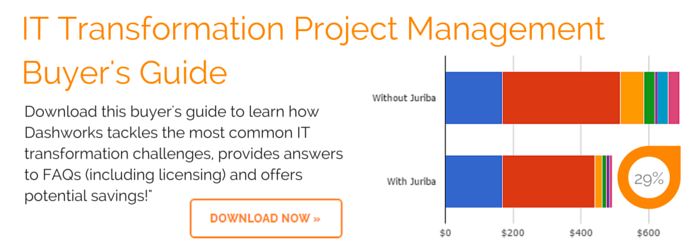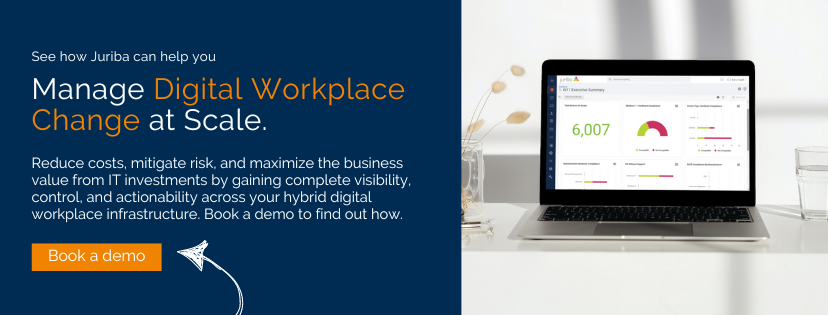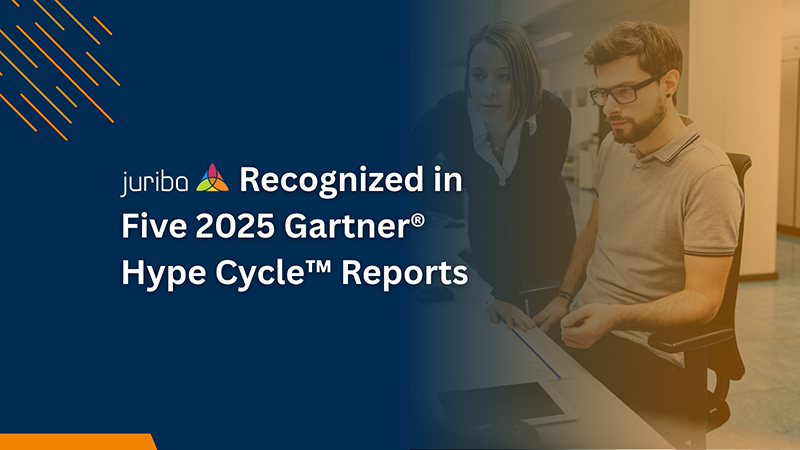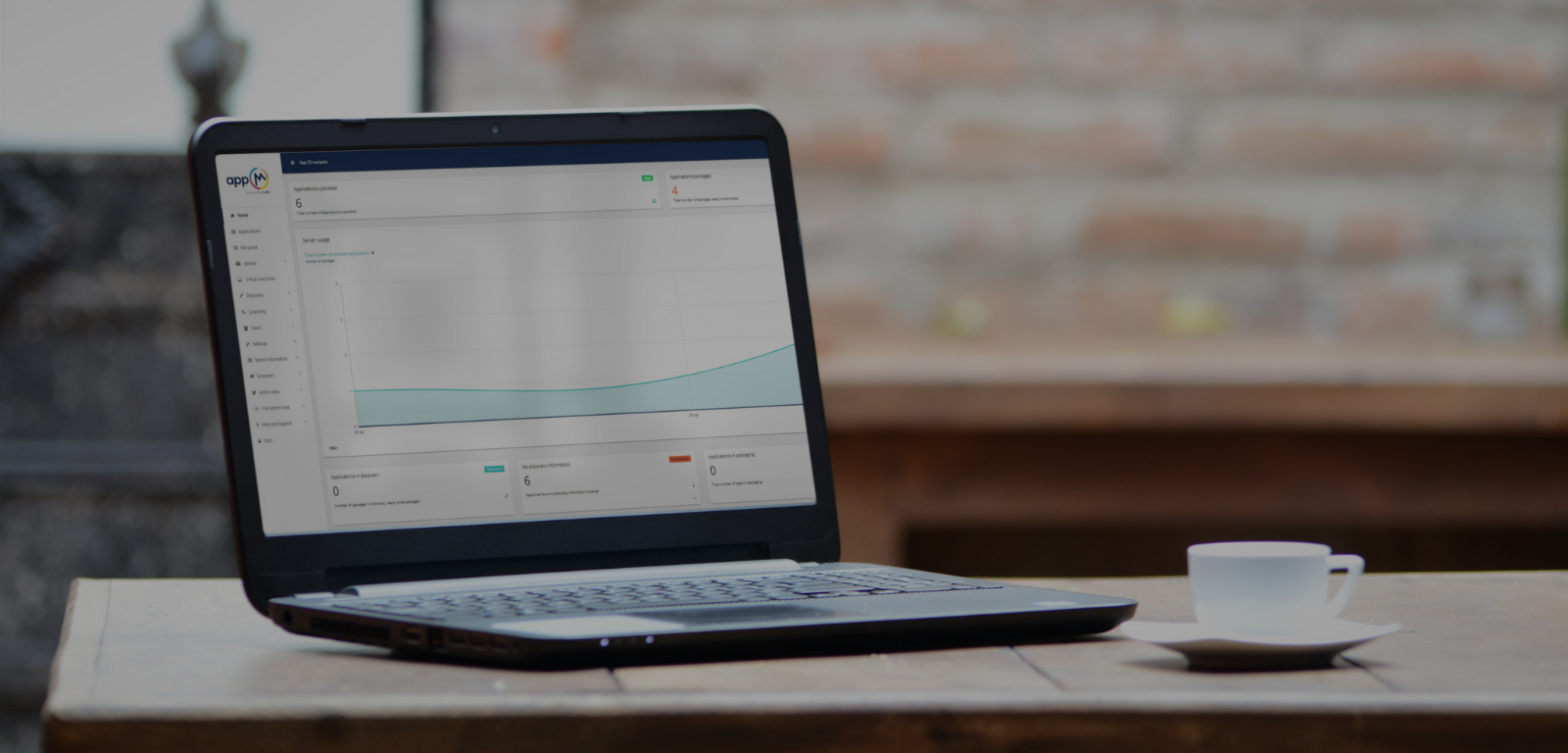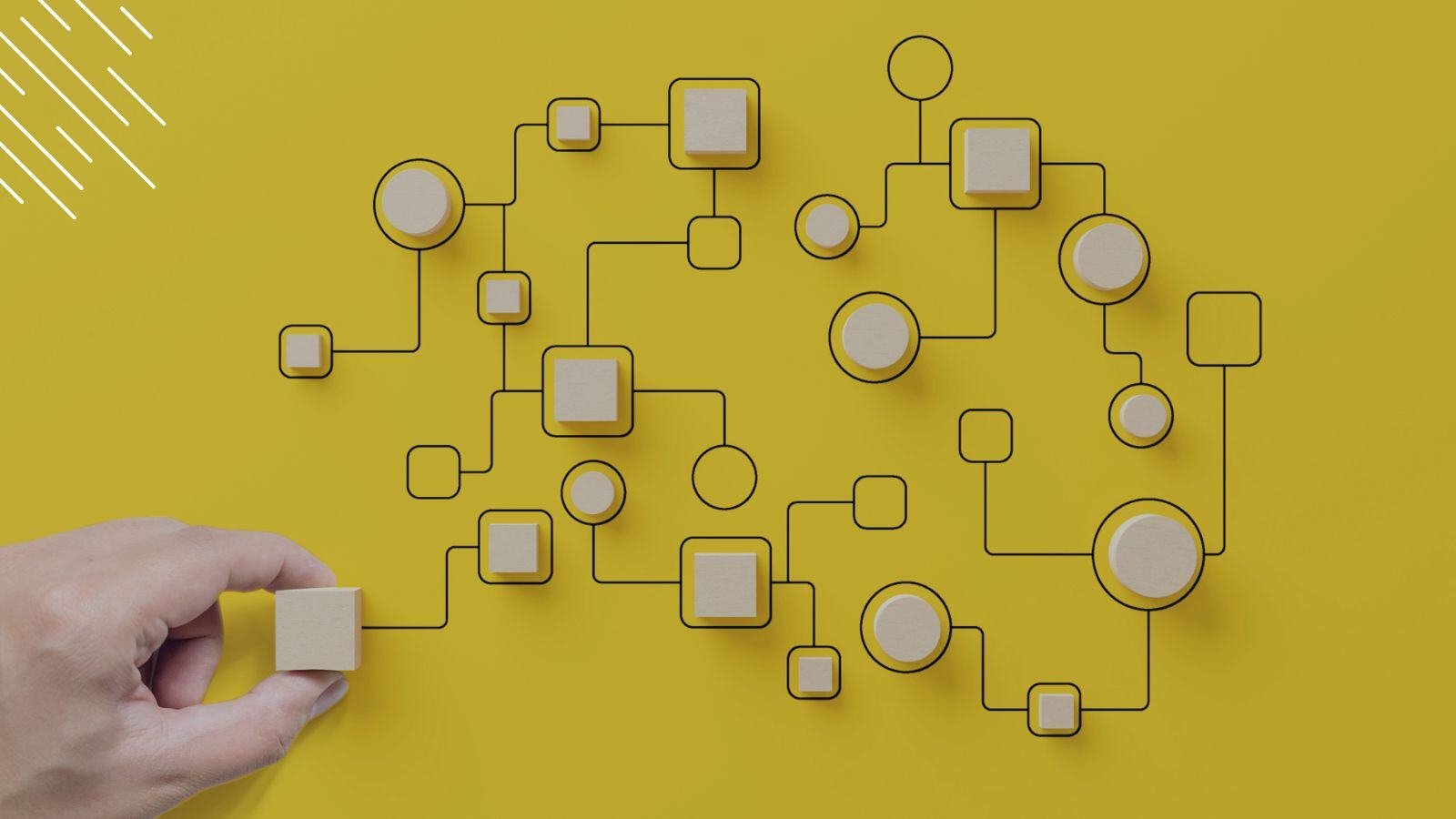Microsoft Windows Analytics (Upgrade Readiness) vs. Juriba Dashworks (Updated 4/12/18)
October 9th, 2017
9 min read
By Barry Angell
%20vs.%20Juriba%20Dashworks%20(Updated%2041218).jpg?width=1600&height=900&name=Microsoft%20Windows%20Analytics%20(Upgrade%20Readiness)%20vs.%20Juriba%20Dashworks%20(Updated%2041218).jpg)
One of the most frequent questions we get when we talk to potential customers about tooling is: "What about Microsoft Upgrade Readiness? How does Dashworks compare to that?" It's a very valid question since the Microsoft tool is available free of charge and also built by Microsoft. Since no one knows Windows 10 as well as Microsoft does, one can assume that they also know how to best ready and deploy it using proven industry practices.
However, there are significant differences in how both tools help deliver a Windows 10 migration or Windows 10 servicing model project. Of course, both have their advantages and disadvantages and need to be the right fit for your organizational needs, so today I want to take a closer look at those. But before we try to unravel the differences, let's get a first impression of each product.
Note that Windows Analytics also includes two additional components; Device Health and Update Compliance. These elements provide further support information on the devices for use in a standard operating environment, and not considered in this bake-off.
Microsoft Windows Analytics - Upgrade Readiness Overview
Microsoft Upgrade Readiness, formerly known as Upgrade Analytics, is a completely cloud-based tool that is marketed by Microsoft under the wider umbrella of Windows Analytics, which now also includes Update Compliance and Device Health (both still in public preview). Microsoft describes the tool as having:
"powerful insights and recommendations about the computers, applications, and drivers in your organization, at no extra cost and without additional infrastructure requirements. This new service guides you through upgrade and feature update projects using a workflow based on Microsoft recommended practices. Up-to-date inventory data allows you to balance cost and risk in your upgrade projects."
To get started, you go to the Microsoft Operations Management Suite (OMS) and sign up for an account with Azure AD ID or a Microsoft email address. You then can add Upgrade Readiness to your workspace and work through a list of prerequisites that you have to fulfill before you can start working. Primarily, this involves switching on the Windows 10 telemetry gathering agent to push data to the cloud under your organization's bespoke id. After these prerequisites have been taken care of, it takes about 48 hours for the telemetry data to load. Now you are ready to view a short workflow — (1) Choose Windows 10 Version, (2) Prepare Your Environment, 3) Resolve Issues, and 4) Deploy — that leads you from left to right. Each card is clickable and opens up a deeper level of detail.
Once the telemetry data has loaded, you will get an overview of the number of devices to migrate, the number of already upgraded machines, as well as the total number of applications. Microsoft then recommends that you run a pilot including all devices that have no known-to-Microsoft system or application issues. However, they do caution you to pay attention to potential driver issues. After a successful pilot, you will be prompted to prioritize your applications.
If you click into the list of applications, you can manually annotate your application criticality level (Not Reviewed, Review in Progress, Business Critical, Important, and Ignore) by selecting the individual application and choosing from the drop-down box. The tool will also provide you with the app usage in the last month based on available telemetry data to make the selection easier.
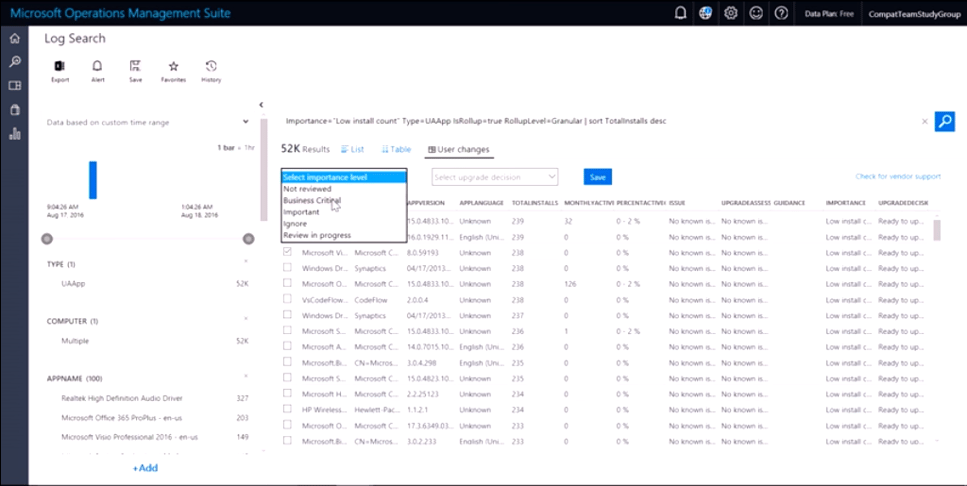
Next, you move into the "Review Issues" step of the workflow. Here, you will be able to review all applications and drivers with known (to Microsoft) issues and receive guidance on possible fixes based on data available to Microsoft. You can also review applications with no known issues. If you click into that list, you will see the applications categorized based on your previous, manual annotation. Now you can, for example, choose to further annotate all business-critical applications and then manually select and assign upgrade settings (e.g., not reviewed, review in progress, ready to upgrade, won't upgrade). Please note that updates won't be reflected until the next day.
Lastly, in the deploy stage, you can export a list of all ready-to-upgrade computers and upload it into your deployment management tool. If you are using Microsoft SCCM, you will be delighted to know that Upgrade Readiness includes the SCCM ID in the export data for easier deployment.
Cost: Microsoft's Upgrade Readiness offering is free of charge.
Juriba Dashworks
Juriba's Dashworks, on the other hand, is an enterprise end-to-end IT Transformation Management tool that can be deployed on-premise or in the cloud. It is freely configurable and therefore suitable for one-time projects as well as Business-as-Usual or Evergreen IT environments.
First, you need to gather your user, application, and computer data. Dashworks seamlessly connects to your existing repositories using certified connectors to tools like Active Directory and SSCM, but also HR and other business application feeds. All relevant project data is collated in minutes and aggregated into the central data warehouse where you can add locations and departments or apply custom fields.
-1.jpg?width=967&height=417&name=Dashworks%20-%20Windows%2010%20Branch%20Information%20(Blog%20Screenshot%20I)-1.jpg)
The optional Dashworks Analysis+ module will automatically check the data quality, and identify and eliminate 60-80% of the irrelevant applications, such as drivers, language packs, and hot fixes. It will also cross-check that your locations show the correct number of end-users and devices, and will set an application compatibility status for 'known' software and use rules to show which hardware you will support on the target operating system and what needs upgrading. You can also normalize, categorize, and rationalize your entire software and hardware inventory automatically — which allows you to cleanse and better manage your inventory.
Now that you have all the relevant information, it is time to create your project by telling Dashworks which migration dependency tasks you wish to track and whether you want to support different migration paths (in-place upgrade, wipe and load or replace), as well as define your deployment rings, groups and teams. Now, you can also configure your end-user self-service portal and your automated email communication capabilities. Dashworks comes preinstalled with industry best practices and is easy to configure to meet your project requirements.
.jpg?width=903&height=634&name=Dashworks%20-%20Windows%2010%20Branch%20Information%20(Blog%20Screenshot%20II).jpg)
It's time to get the ball rolling on your project as you onboard all your in-scope users, applications, and devices. Dashworks automates as much as possible — for example, your migration will inherit the default readiness status setting, but you can further analyze and augment to adapt workflow to the needs of your project. Because of this, your schedulers can hit the road running with low-hanging fruit and group more complex migrations into groups based on their app dependencies or whether or not they need new hardware.
As you are migrating users, emails are triggered automatically, and further data is validated and rationalized through the self-service portal. Application feeds tell you the latest status for your application packages, while dashboards display real-time progress and what is holding up the most users. As your readiness items complete and your users turn green, it is time to lock in the schedule. Your engineer drop sheets are generated, final emails are sent, and the logistics activities are set in motion. Dashworks triggers the migration activity and reports back on deployment success. Finish strong with post-migration clean-up tasks: hard drive wipes, computer disposals, inventory updates and, of course, your project status report.
Cost: Juriba will charge a perpetual license fee upon installation of the software at the client site. Alternatively, for clients who have a specific requirement (e.g., a project that is due to run for 12 months), there is a fixed-term license available. However, it is important to know that the break-even point for perpetual versus fixed term is roughly 18 months, so be sure to choose perpetual license for long-term projects or multiple projects!
Side-by-Side Comparison of Windows Analytics Upgrade Readiness & Juriba Dashworks
While these tools are both designed for Windows 10 migration management, they are very different, taking a completely different approach to migration readiness, scheduling, and deployment. It is worth looking at them side by side to visualize the differences.
| Criteria | Microsoft Upgrade Readiness | Juriba Dashworks |
| Data Collection | Microsoft collects data based on telemetry, which means that the collected data will be sent to an external cloud service which is not configurable from the client side. It requires an internet connection and 24-48 hours to load. | The data is pulled from existing management systems, such as SCCM, Ivanti LANDesk, Lakeside SysTrack, etc. You can even add data from the Upgrade Readiness tool. You do not need a constant network connection. Data is loaded overnight. |
| Security Concerns | You need to have an internal security review concerning which data is being collected, which data is being submitted to the cloud, how data is saved, and who can access the data. | If you are using the on-premise version, all data stays in-house. This can include all virtual, physical and on private Azure-hosted devices. If you are using the cloud version, you configure all the settings. |
| Hardware Inventory | Hardware inventory information is not available. | Manufacturer and model is displayed and normalized with Analysis+ (e.g., HP, Hewlett-Packard), Lifecycle information is added (RTM, EOL). |
| Software Inventory | Based on collected telematry data. Includes a list of product names, manufacturer, version, and on which machines it is installed. The inventory is executable based and normalized where possible. | Juriba's robust, state-of-the-art connectors pull near-time inventory. Includes a list of product names, manufacturer, version, and on which machines it is installed, usage data, and lifecycle infomation (RTM, EOL, support status). |
| Application Normalization | Manual - possible to consolidate minor versions into one product. | This happens automatically with Dashworks Analysis+. Based on BDNA's Technopedia catalog with more than 120 million entries, thousands of data fields will be consolidated into a cleansed application estate. |
| Application Categorization | Limited. You can use manual annontations and decide for each product if they are needed for migration. | 60-80% of the applications (drivers, hot fixes, language packs) will be automatically categorized as irrelevant. With Dashworks Analysis+, if products are known, they are identified as mapped. Otherwise, they get the status unknown - for example in-house applications. |
| Application Compatibility | Known-to-Microsoft products can be categorized based on their compatibility infomation based on 'Ready for Windows' vendor information or derviced from telemetry data (i.e. if it is installed on >10,000 devices running the chosen OS release). | Products can be marked as compatible, incompatible but with a known upgrade path, incompatible, or unknown. If an update is needed, the tool will specify if it is a free or paid upgrade, and which version at a minimum to move to. |
| App & HW Lifecycle | Limited data, based on vendor information | Release to Manufacturing and end-of-life data is available. |
| Location Information | Not out-of-the-box. Devices need to be manually added to a location by using groups. | Data can be added automatically from an HR system, validated by the user or ammended by the team. |
| Department Information | Not out-of-the-box. Devices need to be manually added to a department. | Data can be added automatically from an HR system, validated by the user or ammended by the team. |
| Additional Data Sources (Connectors) | Not supported. | Dashworks supports additional data sources with robust, industry-leading connectors. |
| CSV Feed & Additional Data | Not supported. | Dashworks can import additional data containing end users, devices, applications, locations, mailboxes, guarantee status, direct reports and much more. |
| Search, Filter & Drill-Down | Fuzzy search is possible, only through filters. | Full support of fuzzy search; only three characters are required to generate a list of users, applications, or devices. |
| Access to User Interface | Limited. Access to an OMS console is required. | Dashworks web UI is accessible from every single machine on the company's network given proper credentials. |
| User Interface Limitations | Export of data is limited to 10,000 data lines. To export larger data sets, you will have to work with filters to restrict the amount of data. | No limitations on sorting, filtering or exporting data. |
| Data Manipulation Frequency | Any data changed will only be reflected the next day after the ETL has run | Real-time updates reflected immediately. For example, Any change in application readiness for example will immediately change the status of those devices that require the application. |
| Application Readiness | Limited. Simple manual selection from a dropdown box (not reviewed, review in progress, ready to upgrade, won't upgrade) | Application readiness in Dashworks follows different phases (identification, user acceptance testing, distribution etc). Displays an overview of global readiness as well as the individual readiness of single devices. You can also view application readiness by group. |
| Automated Email Communication | There are no end-user communication capabilities. | Dashworks supports automated email communication with users in different languages. |
| Self-Service Portal | There are no self-service capabilities. | Users can use self-service to validate or edit their information, choose new hardware, volunteer for an earlier migration, and much more in multiple languages. |
| Scheduling & Capacity Management | There are no scheduling and capacity management capabilities. | Dashworks centrally maintains all scheduling information which can be updated in bulk or individually. All changes in the environment are automatically reflected in the tool. Schedules can be constrained by the capacity defined by device group. |
| Deployment Orchestration | All device information has to be exported and imported into a deployment tool. | Dashworks helps you orchestrate your deployment using Microsoft's recommended deployment ring concept or any other way you wish to manage your rollout. |
| Rule-Based Project Workflow | You have to follow the simple 3-step process (Ready, Set, Go!) but there is no check that you have successfully completed them, or any ability to track any other dependencies. | Dashworks is based on rule-based workflows. You can determine which deployment rings to assign users to based on a rule; deployment tasks gets kicked off based on user getting green light, and many more. |
| Task Management | There are no task management capabilities. | In-flight tasks can be assigned to your resources within Dashworks and everything is tracked with a full audit trail. You choose which tasks you want to track. |
| Multiple Project Support | You can change the release version (1507, 1511, 1607 etc) but you have to wait for the overnight run before you can see your data. | Dashworks is designed to be used in an Evergreen IT environment, making project setup and onboarding a snap. |
| Dashboards, Analytics & Report Generation | Limited to a 10,000 exportable lines of data (most application estates for any organisation >3,000 seats will have more than this). | Several dashboards can each display different data segments. Integration with PowerBI, etc. for even more powerful dashboards and data visualization. Reporting possible with other tools such as Excel, Tableau, and QlikView possible. |
| Role Based Administration | There are three roles available; admin, contributor (same as admin but can't add other admins) and read-only (can't change settings, add solutions etc). | Full role based access (either Dashworks or AD based) providing system admin, project admin, schedulers, app management, api users and others. System uses teams and groups to permission which devices/users a resource can view (e.g. limit deployment team to only the buildings they are working in). |
Conclusion
In conclusion, both tools are completely different and should be treated as such.
Microsoft's Upgrade Readiness is well suited for small to medium size companies that have no issues with transmitting data to Microsoft for telemetry purposes and don't expect many application testing issues. Since it is a free, web-based tool, it could even provide additional information to supplement your other data sources, but it won't be enough to manage an enterprise-wide migration with thousands of devices, users, and applications.
Juriba Dashworks is an end-to-end, enterprise-ready IT project management tool that can be used for all kinds of IT transformation projects as well as for ongoing IT management. While the initial costs are substantial, the running costs per machine are negligible — especially considering the expected return-on-investment (e.g., $200 savings per machine on a Windows 10 migration).
Barry is a co-founder of Juriba, where he works as CEO to drive the company strategy. He is an experienced End User Services executive that has helped manage thousands of users, computers, applications and mailboxes to their next IT platform. He has saved millions of dollars for internal departments and customers alike through product, project, process and service delivery efficiency.
Topics:


